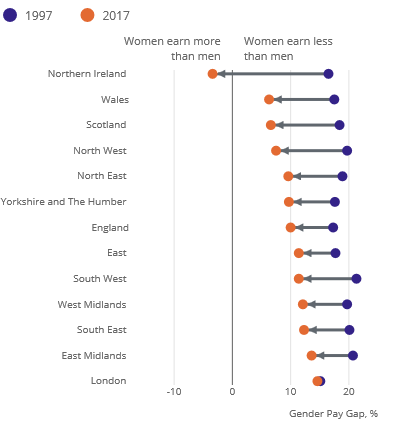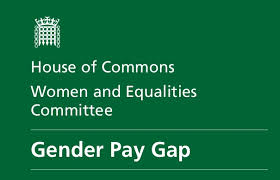Gender Pay Gap Stays Static Say Office of National Statistics
Monday 27 November, 2017 Written by ONS
The pay gap between men and women working in London has barely changed in over two decades, new ONS analysis shows.
While in 1997 the capital had the narrowest gender pay gap, there has been little improvement since then. Other regions in the UK have seen more movement towards pay equality over time.
Women working full-time in London earned 15.1% less per hour, on average, than their male counterparts 20 years ago. This has only narrowed slightly in 2017, to 14.6% in favour of men.
London is now the region with the biggest pay gap, on average, between male and female full-time workers in the UK.
The analysis also demonstrates striking changes in the gender pay gap when it comes to where you work, the hours you work, and also whether you work in the public or private sector.
Image: Link to House of Commons Women & Equalities Committtee
In the last two decades, consecutive governments have sought to address the gender pay gap using legislation. One of the most recent is legislation requiring all companies with more than 250 employees to publish the gender pay gap among their staff.
There are still clear regional differences in earnings between men and women working full-time. In Northern Ireland, women earn 3.4% more per hour, on average, than their male counterparts, the only region in the UK where the pay gap has been in favour of women, and this has been the case since 2010.
The gap in Wales and Scotland has narrowed over the last two decades, and now women earn 6.3% and 6.6% per hour less than men, respectively. In 1997, women earned 17.5% less than men in Wales, and 18.4% less in Scotland.
Among part-time workers, the picture is a little different regionally. The gender pay gap has reversed in some places, with women now earning more, on average, than men across all regions. The pay differences are largest in Northern Ireland, London and Wales.
The gap in the North East was particularly large in 1997 with part-time women earning 7.2% less per hour, on average than men, and now women earn 3.6% more than men.
The region with the smallest gender pay gap is the South East, where women earn just 3.1% more per hour, on average, than men. This gap has actually reduced from women earning 9.0% more than men in 1997, suggesting that men’s wages have grown quicker than women’s in this area.
Gender pay gap per hour by region and country, 1997 and 2017, UK

Part-time workers in the public sector have seen the gender pay gap widen over the last 20 years.
Women working part-time earned 6.1% per hour less than men working part-time in 1997, whereas in 2017 they earn 22.3% less.
In the private sector, the opposite is true. In 1997, women working part-time earned 2.2% less than men. In 2017, the gap has reversed and women now earn 2.6% more than men. The gap has been in favour of women since 2010.
Gender pay gap per hour for part-time workers by public and private sector, 1997 and 2017, UK

Image: This is part of a larger ONS report.
Here are links to European Union Documents about gender inequality.
Strategic engagement for gender equality 2016-2019
Strategy for equality between women and men
Annual Reports on Equality between Women and Men
Gender balance in decision-making positions
Leave a comment
Make sure you enter all the required information, indicated by an asterisk (*). HTML code is not allowed.
Join
FREE
Here











